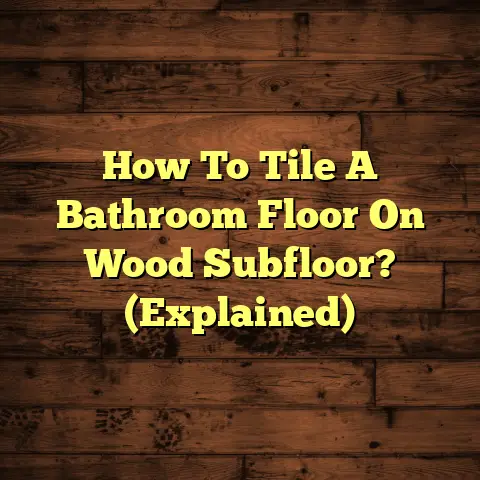Solid Wood Floors: True Durability? (5 Facts)
Do you remember the first time you stepped onto a beautifully polished hardwood floor?
The warmth of the wood beneath your feet, and the sense of timeless quality it brought to the room?
I do. It was in my grandma’s house, a place filled with memories and that floor was a silent witness to all of them.
That feeling, that connection, is what makes solid wood flooring so special. But beyond the nostalgia, is it really durable?
Let’s dive into 5 facts to uncover the truth.
Fact 1: The Definition of Solid Wood Flooring
Okay, let’s get down to brass tacks. What exactly is solid wood flooring?
Simply put, it’s flooring made from planks milled from a single piece of wood.
No layers, no funny business. Just pure, unadulterated wood from top to bottom.
This is what sets it apart from engineered wood, which has a thin veneer of hardwood glued to a plywood core.
Think of it like this: solid wood is like a steak, while engineered wood is like a hamburger (still good, but different!).
Now, what kind of wood are we talking about?
You’ve got your classics like oak, maple, and cherry.
-
Oak: The workhorse. It’s tough, readily available, and takes stain beautifully. Red oak and white oak are the two main varieties, each with its own distinct grain pattern.
-
Maple: Known for its clean, modern look. It’s lighter in color than oak and has a tighter grain, giving it a more uniform appearance.
-
Cherry: Offers a rich, reddish-brown hue that deepens over time. It’s a softer wood than oak or maple, so it might show wear and tear a bit more.
But there’s a whole world of other options too!
Think walnut, hickory, ash, even exotic species like Brazilian cherry or tigerwood. Each species brings its own unique character and hardness to the table.
The construction process is pretty straightforward.
Logs are sawn into planks, kiln-dried to remove moisture (this is crucial for stability!), and then milled with a tongue-and-groove edge for easy installation.
This simple construction, using the natural strength of wood, is a big part of what makes solid wood so durable.
Fact 2: Longevity and Lifespan
Alright, let’s talk numbers. How long can you really expect solid wood floors to last?
Well, buckle up, because we’re talking decades, even centuries if properly cared for.
I’ve personally seen floors in historic homes that are over 150 years old and still going strong!
Unlike carpet, which needs replacing every 5-10 years, or laminate, which might last 10-20, solid wood is in a different league.
Here’s a little comparison:
| Flooring Type | Average Lifespan |
|---|---|
| Solid Wood | 50-100+ years |
| Engineered Wood | 20-50 years |
| Laminate | 10-20 years |
| Carpet | 5-10 years |
But here’s the thing: longevity isn’t just about the material itself. It’s about how you treat it.
Think of it like a classic car. You can’t just buy a vintage Mustang and expect it to run forever without any maintenance, right?
Same goes for wood floors.
Here are some key factors that influence lifespan:
-
Maintenance: Regular cleaning, using the right products, and addressing spills promptly are essential.
-
Environmental Conditions: Excessive moisture or extreme temperature fluctuations can wreak havoc on wood floors.
-
Installation Quality: A poorly installed floor is more prone to problems like warping, cupping, and gapping.
-
Traffic: High-traffic areas will naturally show more wear and tear.
I remember one homeowner who had beautiful oak floors that were starting to look a little tired.
Instead of replacing them, they opted to have them professionally refinished.
The result was stunning! The floors looked brand new, and they added another 20-30 years to their lifespan.
That’s the beauty of solid wood: it’s an investment that can last for generations.
Fact 3: Resistance to Wear and Tear
So, how tough is solid wood flooring when it comes to everyday life?
Can it handle kids, pets, and the occasional clumsy moment?
The answer is yes, with a few caveats.
Solid wood is naturally resilient, but it’s not indestructible.
The Janka hardness scale is a good way to compare the relative hardness of different wood species.
It measures the force required to embed a steel ball into the wood. The higher the number, the harder the wood.
Here are a few examples:
| Wood Species | Janka Hardness |
|---|---|
| Brazilian Walnut | 3680 |
| Hickory | 1820 |
| Hard Maple | 1450 |
| Red Oak | 1290 |
| Cherry | 950 |
| Pine | 870 |
As you can see, some woods are significantly harder than others.
If you have a busy household with kids and pets, you might want to opt for a harder species like hickory or maple.
But even softer woods like cherry can hold up well with proper care.
Scratches are inevitable, especially with pets.
But the good news is that solid wood can be sanded down and refinished to remove scratches and other surface imperfections.
This is a huge advantage over other flooring types that can’t be repaired in the same way.
Moisture is another potential enemy of wood floors.
Spills should be cleaned up promptly to prevent water damage.
In areas prone to moisture, like bathrooms or laundry rooms, you might want to consider other flooring options.
I once had a client who installed beautiful maple floors in their kitchen.
Unfortunately, a leaky dishwasher went unnoticed for several days, causing significant water damage.
The floors had to be partially replaced, which was an expensive and time-consuming process.
The moral of the story? Be vigilant about moisture!
Despite these potential challenges, solid wood floors are surprisingly resilient.
With proper care and maintenance, they can withstand the rigors of daily life and still look beautiful for years to come.
Fact 4: Restoration and Refinishing Potential
Okay, this is where solid wood really shines.
The ability to refinish solid wood floors multiple times is a game-changer when it comes to durability and longevity.
Think of it as hitting the reset button on your floors.
Over time, even the most well-cared-for floors will start to show wear and tear.
Scratches, dents, and fading can all take their toll.
But with solid wood, you don’t have to live with those imperfections.
Refinishing involves sanding down the old finish, staining the wood (if desired), and then applying several coats of a protective finish.
The result is a floor that looks brand new, with all the character and charm of the original wood.
And the best part? You can do this multiple times over the lifespan of the floor.
I’ve seen floors that have been refinished three or four times and still look amazing.
The number of times you can refinish a floor depends on the thickness of the wood.
Since solid wood is, well, solid, there’s plenty of material to work with.
Engineered wood, on the other hand, has a thin veneer of hardwood, which limits the number of times it can be refinished (if at all).
The refinishing process can be a bit dusty and noisy, so it’s usually best to hire a professional.
But the results are well worth the effort.
I remember one project where we refinished some old pine floors in a historic farmhouse.
The floors were covered in layers of old paint and varnish, and they looked like they were beyond saving.
But after a lot of hard work, we were able to restore them to their former glory.
The homeowners were absolutely thrilled!
They couldn’t believe that the floors they had thought were ruined could be brought back to life.
That’s the magic of refinishing solid wood floors.
It’s a cost-effective way to breathe new life into your home and extend the lifespan of your floors for decades to come.
Fact 5: Environmental Impact and Sustainability
Let’s talk about something that’s becoming increasingly important: sustainability.
How does solid wood flooring stack up when it comes to environmental impact?
The good news is that solid wood can be a very sustainable choice, especially when sourced responsibly.
Wood is a renewable resource, and when forests are managed sustainably, they can provide a continuous supply of timber without harming the environment.
Look for certifications like the Forest Stewardship Council (FSC) label.
This indicates that the wood comes from forests that are managed in an environmentally and socially responsible manner.
Choosing FSC-certified wood is a great way to support sustainable forestry practices.
Compared to synthetic flooring materials like vinyl or laminate, solid wood has a lower carbon footprint.
Wood naturally absorbs carbon dioxide from the atmosphere as it grows, and that carbon remains stored in the wood even after it’s harvested.
Manufacturing synthetic flooring materials, on the other hand, requires a lot of energy and often involves the use of harmful chemicals.
Solid wood flooring can also contribute to a healthier indoor environment.
Unlike some synthetic materials, it doesn’t emit volatile organic compounds (VOCs), which can be harmful to your health.
I always recommend using low-VOC finishes and adhesives when installing or refinishing wood floors.
This helps to minimize any potential off-gassing and create a healthier indoor environment.
Of course, not all solid wood flooring is created equal.
It’s important to do your research and choose a supplier that is committed to sustainability.
Ask about their sourcing practices and look for certifications like FSC.
By making informed choices, you can enjoy the beauty and durability of solid wood flooring while also supporting sustainable forestry practices and protecting the environment.
Conclusion:
So, there you have it: 5 facts that demonstrate the true durability of solid wood floors.
From their long lifespan and resistance to wear and tear to their refinishing potential and sustainability, solid wood floors offer a unique combination of beauty, longevity, and environmental responsibility.
But beyond the practical benefits, there’s something special about solid wood floors that’s hard to put into words.
It’s the warmth, the character, the sense of history that they bring to a home.
It’s the feeling of connection to nature and to the past.
Investing in solid wood flooring is an investment in your home and in your future.
It’s a decision that combines beauty with longevity, creating a space that you’ll love for years to come.
And who knows, maybe your great-grandchildren will be walking on those same floors one day, creating their own memories and connections to the past.





